CIRCLE TIME
(Open circle time game-About me) Print and laminate. You will need a pair of dice. Children take turns rolling the dice and you ask them questions per the result (ex. Do you have a sister?).
Ask children to count from 1 to 6 in English, and then in French (un, deux, trois, quatre, cinq, six), and in Spanish (uno, dos, tres, cuatro, cinco, seis).
Organize an animated discussion. Set oversized dice on the floor and ask children to sit in a circle around them.
You could also set different dice on a parachute and encourage children to name their favorite games that require dice. Fill a bag with a variety of objects used as part of games requiring dice. Your discussion will be even more interesting if you use pictures, illustrations, and pictograms representing various games that involve dice.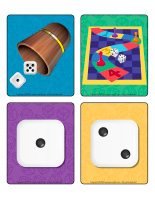
Animated discussion-Dice
(Open picture game-Dice) Print and laminate the pictures in the format you prefer. Use them to spark a conversation with your group. Ask children questions to see what they know about the theme.
Poni discovers and presents-Dice
(Open Poni discovers and presents-Dice) Print and laminate the cards. Cut them out. Use a Poni puppet or another puppet that children are familiar with to present the pictures to your group.
AREA SETUP
Integrating dice throughout your daycare
Here are a few ideas: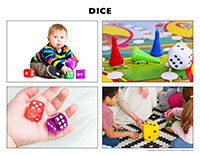
- Provide number-shaped cookie cutters. Find pictures of dice and use adhesive paper to press them on your daycare walls and floor. Stick some under tables, in your workshop areas, on toys, etc.
- Provide dice stickers.
- Cut out and glue dice on paper plates and hang them on a long ribbon to create a garland.
- Hang pictures of dice from the ceiling.
Thematic poster-Dice
(Open thematic poster-Dice) Print, laminate, and decorate the walls of your daycare with all kinds of posters.
Homemade stickers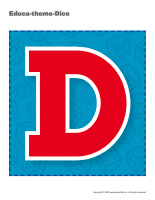
(Open stickers-Dice) Print the illustrations on adhesive paper to create a variety of homemade stickers.
Educa-theme-Dice
(Open educa-theme-Dice) Print and laminate. Use the different illustrations to decorate a corner of your daycare and present the theme to your group (and their parents).
Educa-decorate-Dice
(Open educa-decorate-Dice) Print, laminate, and cut out the various items. Use them to decorate your daycare and set the mood for the theme.
Garland-Dice
(Open models-Dice) Print. Let children decorate the items. Cut them out and use them to form a garland that can be hung within your daycare or near your daycare entrance.
Number and dice chart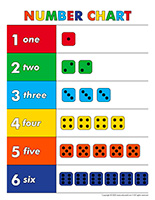
(Open chart-numbers and dice) Print, laminate, and display at children’s level. Using Velcro, children press the correct number of symbols on each line.
PICTURE GAME
The picture game may be used as a memory game or to spark a conversation with the group. The pictures may also be used simply to decorate the daycare or a specific thematic corner. (Open picture game-Dice) Print and laminate. Store the game in a “Ziploc” bag or in your thematic bin.
Memory game-Dice
(Open picture game-Dice) Print the series of illustrations twice and use them for a traditional memory game.
ACTIVITY SHEETS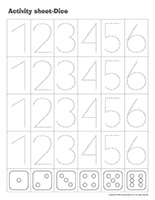
Activity sheets are suggested for each theme. Print and follow instructions. (Open activity sheets-Dice)
Educa-nuudles-Dice
(Open educa-nuudles-Dice) Print for each child. Have children color the sheet and use Magic Nuudles to give it a three-dimensional look. If you don’t have Magic Nuudles, simply ask children to fill the spaces with bingo markers or stickers.
Stationery-Dice
(Open stationery-Dice) Print. Use the stationery to communicate with parents, in your writing area, or even to identify your thematic bins.
LANGUAGE ACTIVITIES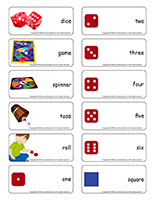
The flashcards may be used during circle time to spark a conversation with the group or in your reading and writing area. They may also be used to identify your thematic bins. (Open word flashcards-Dice) (Open giant word flashcards-Dice) Dice, game, spinner, toss, roll, one, two, three, four, five, six, square
Let’s chat
(Open word flashcards-Dice) (Open giant word flashcards-Dice) Print and laminate the word flashcards. Have each child pick a flashcard and take turns presenting the item to the group. Discuss each item to see what children know about the theme.
Associating words and pictures
(Open giant word flashcards-Dice) Print, laminate, and display the word flashcards on a wall or a large piece of cardboard that can be moved around. Name a word and have children identify the corresponding word flashcard.
Privilege of the day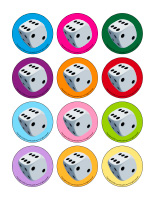
Fill 6 tiny gift bags with different surprises (ex. pyjama day, lunch at the playground, special snack, etc.). Number the bags from 1 to 6. Every morning, challenge your group in a different way. You could encourage them to clean your daycare, respect instructions, etc. During your afternoon circle time, if they succeeded their challenge, have them roll a die and open the gift bag with the corresponding number on it to discover which privilege they earned. If the activity cannot be done the same day, plan to do it the following the day.
ROUTINES AND TRANSITIONS
My dice path
(Open transition games-Dice) Print, laminate, and use adhesive paper to stick the illustrations on the floor, creating a path that leads to various areas frequently visited by the children in your group (bathroom, cloakroom, etc.). If you prefer, you can also use the illustrations to delimit workshops or corners within your daycare.
Game-This is my spot-Dice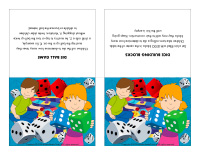
(Open transition games-Dice) Print each illustration twice. Use adhesive paper to secure one copy of each illustration on the table. Deposit the second copy of each illustration in an opaque bag and invite children to pick a card that will determine their spot at the table (corresponding illustration). The illustrations can also be used to determine children’s naptime spots or their place in the task train.
ACTIVI-DICE BOX
This week, the educatall team has created a special game box that you can use to determine which dice game you will play with your group. Simply have children pick a card out of the box. Each game is described on the back of the card. This box can follow you wherever you wish to play dice games (daycare, yard, playground, etc.). (Open activi-dice box) Print, laminate, and store the cards in a decorated box.
Die ball game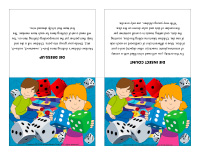
Children roll the die to determine how many times they must tap the ball up in the air. If, for example, a child rolls a 2, he must try to tap or toss the ball up twice without dropping it. Variation: Invite older children to dribble or bounce the ball instead.
Dice building blocks
Set a bin filled with LEGO blocks in the center of the table. Children take turns rolling a die to determine how many blocks they may add to their construction. Keep going until the bin is empty.
Die dress-up
Number children’s clothing items (hat=1, sweater=2, socks=3, etc.). Divide your group into pairs. Children roll a die and help their partner put the corresponding clothing item on. You will need a set of clothing items for each team member. The first team that is fully dressed wins.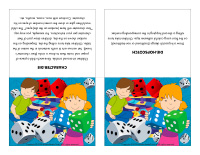
Die insect count
For this activity, you will need a bin filled with a variety of miniature plastic insects (or other objects) and a pair of dice. Glue a different color of cardboard on each side of one die. Children take turns rolling the dice, counting the dots, and setting insects in a small container per the number of dots and color shown on the dice. With very young children, use only one die.
Character-die
Children sit around a table. Give each child a piece of paper and invitee them to draw a circle (their character’s head). Set various arts & crafts materials in the center of the table. Children take turns rolling the die. Depending on the number shown on the die, children draw part of their character per your instructions. For example, you may say, “Your character will have (number on the die) eyes!” The child would then glue or draw the correct number of eyes on his character. Continue with ears, noses, mouths, etc.
Die-hopscotch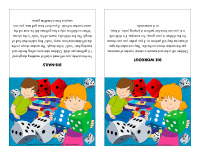
Draw a hopscotch design (traditional or non-traditional) on the floor using colorful adhesive tape. Children take turns rolling a die and hopping to the corresponding number.
Die-nails
For this activity, you will need a ball of modeling dough and 15 golf tees per child. Children take turns rolling the die and inserting their “nails” in the dough. The number shown on the die will determine how many “nails” they add to their ball of dough. The first child who inserts all his “nails” is the winner. When a child has only a few golf tees left, he must roll the exact number to finish. If you don’t have golf tees, you can use pins from a Lite-Brite game.
Die workout
Children roll a die and execute a certain number of exercises, per the number shown on the die. They can select the type of exercise they will perform or, if you prefer, you can choose for the children in your group. For example, if a child rolls a 4, you can have him perform 4 jumping jacks, 4 hops, or 4 somersaults.
Toy car and die course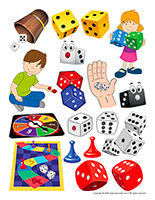
Hang posters numbered 1 to 6 in the lower section of a daycare wall. Children stand in front of the wall, approximately 2 meters away. They roll a die and then roll a toy car to the poster that has the corresponding number on it.
Construct-dice
This is an individual activity. Give the child who is playing a pair of dice. Have him roll them and then add a certain number of blocks to a tower, per the total number of dots.
Ball toss dice
Display posters numbered 1 to 12 on a daycare wall (or outdoor wall). Have children stand in front of the wall, approximately 2 meters away. They take turns rolling a pair of dice. They must add the dots on the dice and then throw a ball towards the poster with the corresponding number.
Trampo-dice
Children stand in line next to your trampoline. When it’s their turn, they roll a pair of dice. They add the spots on the dice to determine how many times they can jump on the trampoline.
Parachu-dice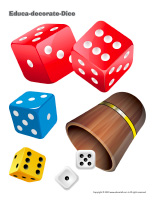
Children stand around your parachute, each holding a handle. Set a die or a pair of dice on the parachute. Encourage them to work together to make the dice bounce up and down. When you give them the signal, they must set the parachute on the floor and count the dots. The total number of dots will determine the number of times they must bounce the parachute up and down for the next round. If you prefer, you can have them turn to the right or the left per the number shown on the die or dice or even use the number to determine how many children must trade spots.
Die bean bag toss
Replace the numbers on your bean bag game with numbers 1 to 6. Children take turns rolling a die. They must try to toss a bean bag into the hole with the corresponding number written on it. You can also simply use a cardboard box and cut six large holes out of it. Number them from 1 to 6 and you are ready to play!
Dice duel
This activity is for 2 players. It requires a pair of dice. Give each child a certain number of buttons (or playing pieces, marbles, etc.). Both children roll one die. The child who rolls the bigger number steals one of his opponent’s buttons. The game continues until one child no longer has any buttons.
Rabbit race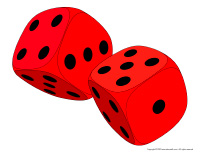
On a large piece of cardboard, draw a big checkered square. You must have one column for each child in your group and the same number of squares in each column. Children choose a small rabbit figurine (or a rabbit-shaped eraser) and set it on their start line. They take turns rolling a die and moving their rabbit down their column a certain number of squares, per the number shown on the die. The first rabbit that reaches its final square wins.
Die-walk
The early childhood educator rolls a die to determine how many steps children must take down the corridor, towards the door. If you prefer, have children take turns rolling the die. You could also, for example, have children roll the die to determine how many carrots they will have on their plate at lunch time.
Snakes & ladders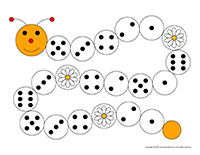
Build a giant snakes & ladders game with your group by sticking several pieces of heavy paper together, creating a path. Children roll the die and move from one piece of paper to the next, per the number shown on the die.
Rolling dice
Set a bin filled with dice of different sizes and colors on the table and let children explore the contents of the bin freely. They will enjoy tossing and rolling the dice.
Ball pit and hidden dice
Fill a kiddie pool with multicolored balls. Hide a variety of dice among the balls. Let children play in this ball pit so they will discover the dice.
COGNITIVE ACTIVITIES
Dice caterpillar
(Open dice caterpillar) Print and laminate for durable, eco-friendly use. A child rolls the die and colors (or sets a playing piece on) the corresponding space. The game continues until the caterpillar is completely colored or covered.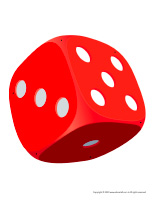
Lacing-Dice
(Open lacing-Dice) Print, laminate, and punch holes around the contour of the models. Children thread a piece of yarn, string, or ribbon through the holes.
Roll and color-3D
(Open roll and color-Snowman) Print for each child. A child rolls a die and colors or cuts the corresponding picture. The game continues until the child’s character is fully colored or assembled.
CULINARY ACTIVITIES
Prepare cupcakes or muffins with your group. Cut them into cubes and invite children to spread frosting all over them. They can press 1 to 6 chocolate chips on each side to make them look like dice.
ARTS & CRAFTS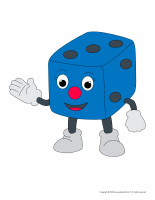
Puppets-Dice
(Open puppets-Dice) Print for each child. Have children color them and cut them out (depending on their age). When they are done, they can decorate their puppet with a variety of arts & crafts materials and glue a Popsicle stick behind it.
Models-Dice
(Open models-Dice) Print and let children decorate the models. Use them for various activities and projects throughout the theme.
Dice cutting
(Open dice cutting) Print. Have each child pick a die and cut it out.
COLORING PAGES
(Open coloring pages theme-Dice) Print for each child.
Color by number-Dice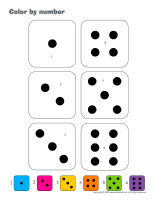
(Open color by number-Dice) Print for each child. Children roll a die and color the portion of the picture that contains the number shown on the die (1 to 6).
Homemade color by number drawings
Use coloring pages to create original color by number activities. Simply add a legend to the bottom of each page (ex. 1=blue, 2=red, etc.). Children roll a die and color the sections containing the corresponding number per the legend.
Group coloring activity
Cut a coloring page into pieces so that you have a piece for each child in your group. Children color their piece. When they are done, reassemble the picture and encourage children to admire their work.
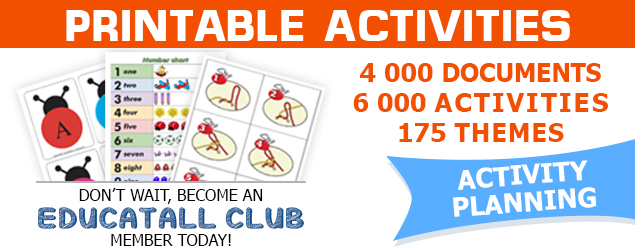
 Home
Home Theme activities
Theme activities
 Babies and toddlers
Babies and toddlers
 Arts and crafts
Arts and crafts
 Science
Science
 Creative recipes
Creative recipes
 Tips and tricks
Tips and tricks
 Special needs
Special needs
 Extra activities
Extra activities
 Educ-TV
Educ-TV
 Newsletter
Newsletter  Online store
Online store Educatall club
Educatall club

